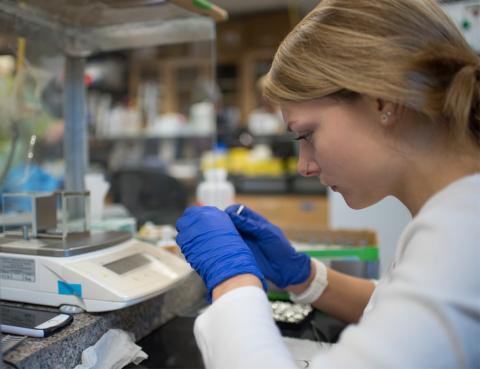Research in the Department of Molecular, Cellular and Biomedical Sciences involves undergraduate and graduate students working alongside their faculty advisors. The ongoing research opportunities in the college are structured to mentor students in education, leadership and science, producing yet another high-quality result dedicated, motivated, highly employable graduates.
One of the best ways to find out about the wide variety of research projects being conducted is to visit the MCBS faculty profile pages and read about the exciting research that is being conducted in research laboratories across campus. Brief overviews of our research areas also are listed below.

Undergraduate Research Areas
BMCB majors can take advantage of the outstanding research programs offered by BMCB faculty by getting involved in an undergraduate research experience. Funding is often available to support undergraduate research either through external grant funds or through the Hamel Center for Undergraduate Research. Talk to your faculty adviser or visit individual BMCB faculty Web sites to learn more about the diverse, exciting research programs.
Most of the faculty involved in this academic program combine a passion for teaching and student advising with strong research expertise in their discipline. Many faculty have well-funded, active research programs and welcome undergraduate student into their labs as lab assistants or to engage in an independent research project using cutting edge equipment and techniques.
If you are interested in getting involved in research activities, please visit the Faculty listing and explore the research interests of our faculty. Identify one or more faculty whose research program interests you, and schedule to meet with them to discuss whether working in their lab might be possible.
Molecular Genetics - The structure and function of genes at a molecular level
- How is gene expression regulated?
- How are genes transferred from one generation to the next?
- Which mutations are involved to cancer and other diseases?
Evolutionary and Population Genetics - Effect of genetic change and natural selection during evolution of populations
- How do organisms adapt to new environments?
- How do new species evolve?
- How do allele frequencies change over time in a population?
Genomics, Proteomics and Bioinformatics - identification, analysis & comparison of all genes and proteins in an organism
- How many genes does an organism have?
- How closely related are two different species?
- What proteins are important for mitosis or other processes?
Graduate Research Areas
Study the relationships that exist between microorganisms and the environment, including the composition, structure and physiology of microbial communities. The environment not only consists of the soil, water, air, sediment, and rocks covering the planet, but also includes the animals and plants that inhabit these areas and microbes that exist in artificial environments such as bioreactors. Research in environmental microbiology is highly diverse and employs multiple cross-disciplinary approaches. A number of UNH faculty are engaged in a variety of collaborative research programs addressing fundamental environmental issues addressing how organisms respond to environmental changes. Learn more about environmental microbiology research.
The source of all genetic variation is mutation. As such, the mechanisms dedicated to maintaining the fidelity of genome replication are fundamental to biology. Genome instability is a common aspect of many diseases such as cancer, as DNA is continually altered by an array of mutagenic agents from the environment and cellular metabolism. The mechanisms that monitor and repair DNA damage are very complex, yet surprisingly very well-conserved, from single-celled microorganisms (such as yeasts), to plants, to humans.
Just as mutation is essential to evolution of new traits, and ultimately new species, variation in mutation shapes genome evolution. Molecular ecology surveys genetic variation that may underlie adaptation to new or changing habitats, mapping the patterns of variation across landscapes. Learn more about genome maintenance, evolution, and molecular ecology.
No higher organism lives in isolation from a myriad of microbes. Associating microbes can either secure host nutrients by siege (causing disease) or by mutual consent (sometimes promoting the health of their partners). At the same time, both plant and animal hosts employ barriers to infection by pathogens, obstacles that challenge foe and friend alike and shape the adaptive evolution of microbial populations. The complexity of these different associations provides an exciting framework for discovery. A number of research programs at UNH explore this interface providing interdisciplinary training in microbiology, ecology, evolution, molecular biology, biochemistry, genetics, genomics and bioinformatics, with long-term applications of relevance to both applied and basic science. Learn more about host/microbial interaction research.
Signal transduction is the study of how cells control their own and each others' behaviors through physical (light, sound) or chemical (hormone, neurotransmitter) signals. Signal transduction research is an intensely active field of research, and UNH faculty are engaged in a variety of research programs that employ biochemical, molecular, cellular, and genetic/genomic approaches to understand cellular communication. Learn more about signal transduction research.
The enzymatic, scaffolding, trafficking and regulatory functions of proteins are carried out on the platform of their three-dimensional structures. Mechanistic insights on diverse cellular processes can be derived from the characterization of protein structures, including their 3D structure and hydrodynamics, spatial and temporal regulation of protein interactions, and protein glycosylation. A number of UNH research programs are addressing the structure/function relationship of proteins and protein assemblies with diverse spectroscopic approaches utilizing centrifugation, mass spectrometry, and chemical or fluorescent labeling. Learn more about structural biology and proteomics research.